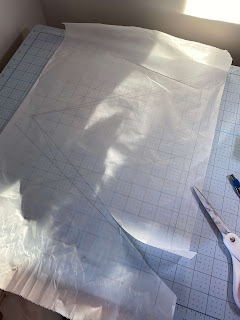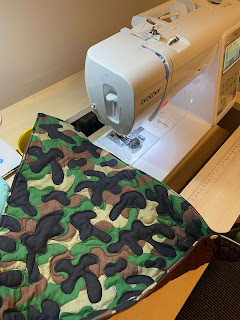This article is brought to you by Lizzsews.
In today's article, I will guide you through how I made a fabric tray- with three sides. Follow along with this project and share your result in Lizzsews Facebook group.
In today's make, I wanted to create something but wasn't quite too sure about the dimensions of it. I had to make changes along the way. I wanted to sew a fabric tray, but this time I wanted it to have three corners rather than four.
Recommended read: How I made article series
Recommended read: How to sew a fabric tray
I wanted to have a base for my seat so it would stay on top of the snow rather than sink into the snow. I figured a tray would be perfect as it would have built-in spots for the feet of the chair to go into!
What I used:
Cotton fabric
Fleece (in replacement of batting)
Something to mark the fabric with
Parchment paper and pen
Iron
Rotary cutter and self-healing cutting mat
Sewing machine and supplies
The steps I took:
I started out by drafting my pattern, I drew it out on some parchment paper close to the exact finished size that I wanted and rounded the corners around each leg. Next, I took another piece of parchment paper and placed the other piece on top. I used a ruler to draw a straight line along each side and made the lines longer than the end of the original draft.
Now I had a new pattern that had pointed corners, a triangle. The triangle was not perfectly symmetrical, but that didn't matter. I ironed my fabric and placed the pattern on top of it. Using a chalk pencil and my seam gauge, I marked out dashed lines 2" away from the pattern. Then using my acrylic ruler, I connected all the dashed lines into one straight line. I did those two steps for all three sides. I made it so that each line was a little longer. Now I connected the lines into points, this is why I made the lines longer.
But, two of my corners ran off the fabric, the fabric just wasn't large enough. I cut the fabric to size and using the cut-off pieces of fabric, I sewed it to the corner. I ironed the seam down and cut the corner to size with the triangle and repeated with both.
I used the fabric rectangle as a pattern to cut out the other piece of fabric and the fleece.
Recommended read: How to sew a fleece embroidered patch pillow
Using the same steps as in my how to sew a fabric tray article I created a tray. The only difference was that I stopped at step 5 (after the free motion quilt).
I made chalk lines 2 1/2" tall on each corner and pinned them.
I folded them in and tested it with the seat, but it didn't fit quite right, it was too tight. After a couple more tries, I ended up with a ≈1 7/8" tall line and was happy with how it fit. I sewed along the line for each corner and flipped the tray, pushed out the corners and it was complete!
I'm very happy with the result and how the tray came together! I can't wait to try it on the snow.
*Update: It worked wonderfully on the snow!









Comments
Post a Comment